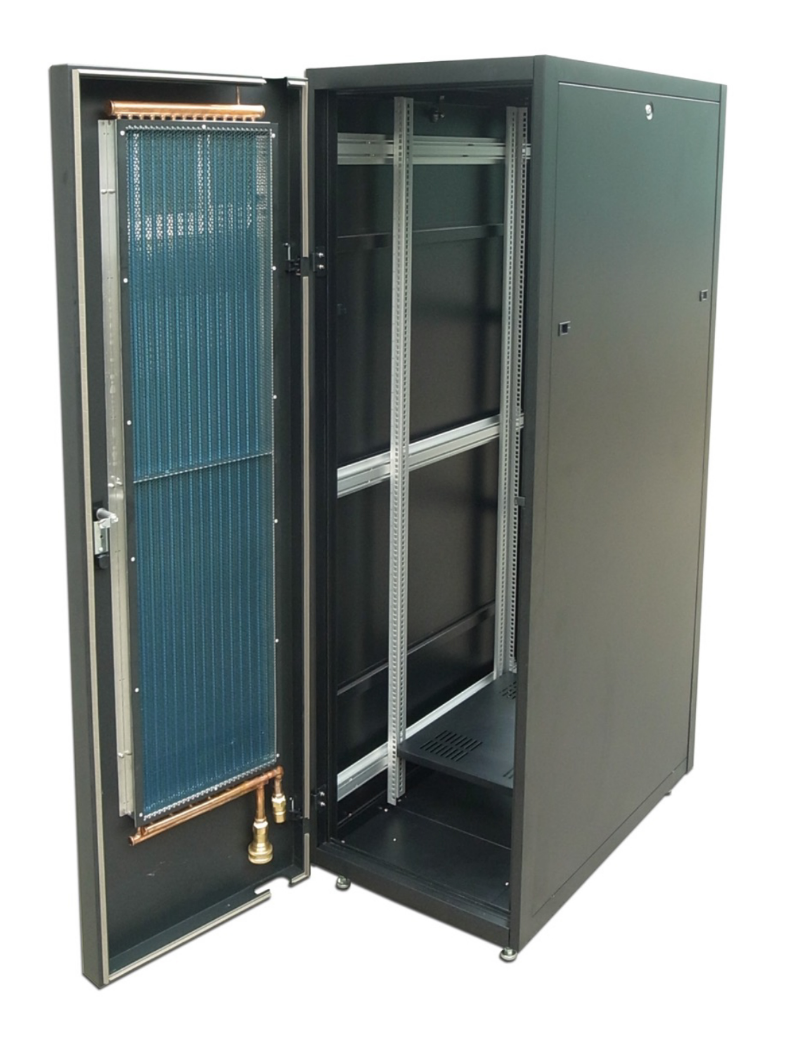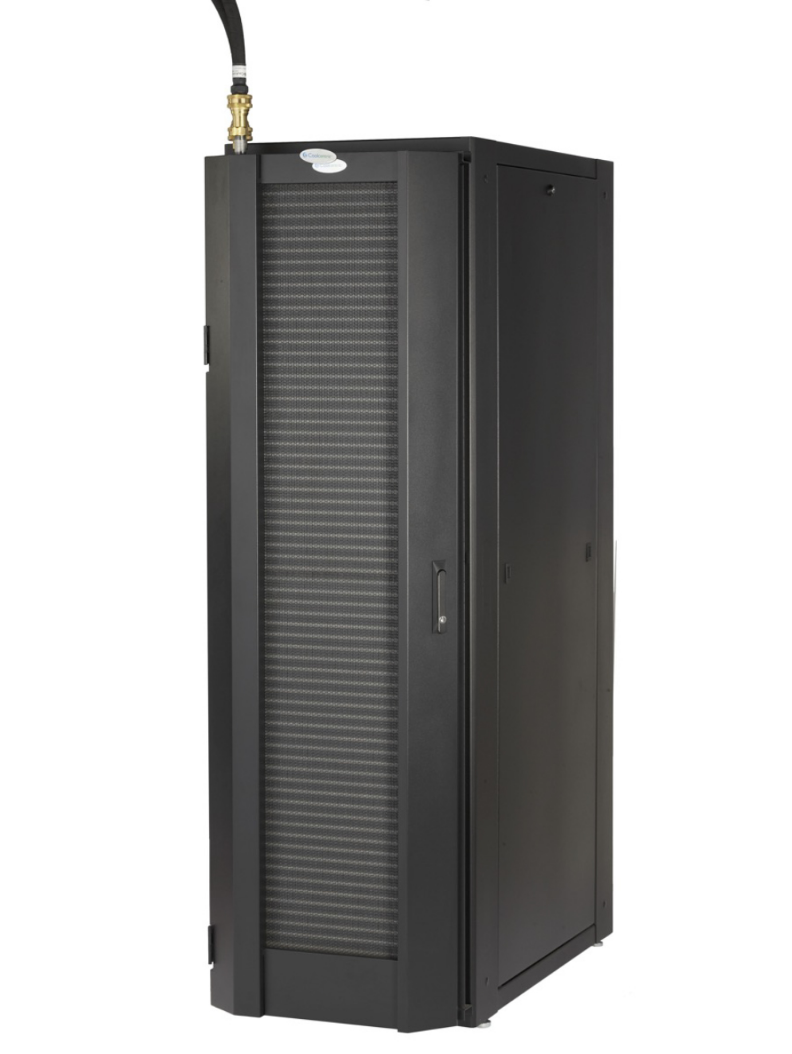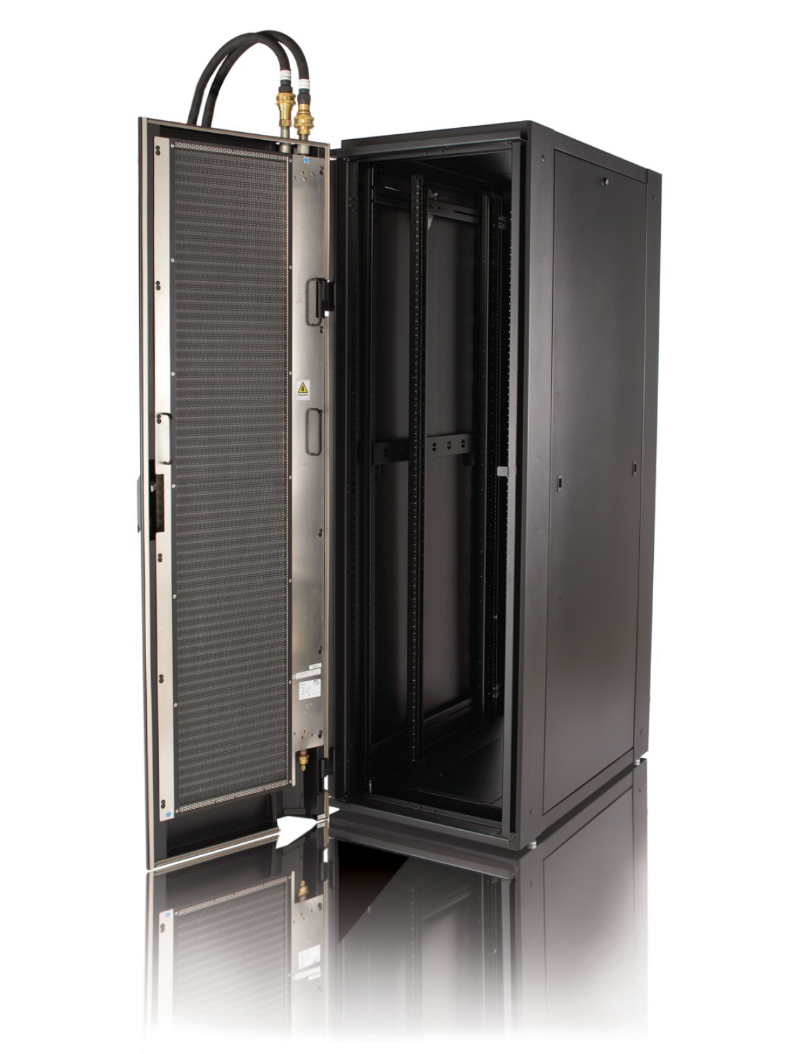
Coolcentric's Heat Exchangers
Coolcentric Heat Exchangers
The Coolcentric family of rear door heat exchangers comprises passive and active liquid cooled server rack heat exchangers. Replacing standard rear doors on IT rack enclosures by using the chilled door rack cooling system draw cool supply air through the chassis. The heated exhaust air passes through a liquid-filled coil, transferring heat to the liquid with cool neutralized air flowing back into the data center. Specially designed fin and tube coils are protected by two 79% open perforated sheets, to maintain airflow through the IT enclosure. Close-coupled to the IT enclosure, the heat exchangers bring cooling as close to the heat source as possible thus providing the ultimate containment solution. Taking up a minimum of floor space, the Coolcentric heat exchangers are flexible, efficient and space-saving turn-key cooling solutions.

Low Density Heat Exchanger

Standard Density Heat Exchanger

Ultra-High Density Heat Exchanger

Active Door Heat Exchanger
In the product suite are Coolant Distribution Units, which monitor and manage the flow of cooled, treated water in a closed loop environment to the Heat Exchanger Units. Coolcentric designs and manufactures a full breadth of standard custom hose kits and external manifolds. Factory certified technicians are available to provide installation, commissioning, and preventive maintenance throughout the world.
Data centers are at a crossroads. Demand for computer storage and communications capacity is growing rapidly. IT equipment is consuming more power and generating more heat. Electric rates are projected to increase in the coming years. Meanwhile business and economic pressures are forcing enterprises to consolidate facilities, streamline operations and aggressively drive down IT costs.
How can you address these conflicting demands and grow data center capacity while reducing costs?
As the average heat density per enclosure increases, it becomes increasingly
difficult to provide the cooling necessary to properly operate the data center. In some cases, the cooling that must be
provided is two times what the heat loads truly require, due to inefficiencies within the cooling system. Data center
managers and designers are now looking beyond the typical perimeter cooling topology using computer room air conditioners
(CRAC) because the needs of today's data centers have surpassed the capabilities of typical units.
Coolcentric Rear Door Heat Exchanger Benefits
| Low Density | Standard Density | High & Ultra Density | Active Door | |
|---|---|---|---|---|
 |


|



|



|
|
| Heat Loads | Completely neutralizes heat loads up to 8kW | Completely neutralizes heat loads up to 20kW | Completely neutralizes heat loads up to 40kW | Completely neutralizes heat loads up to 35kW |
| Condensation | 100% Sensible cooling with no condensation issues | 100% Sensible cooling with no condensation issues | 100% Sensible cooling with no condensation issues | 100% Sensible cooling with no condensation issues |
| System Type | Passive | Passive | Passive | Active |
| Electrical Needs | No connection needed | No connection needed | No connection needed | Electrical connection needed |
| Energy Benefits | No Electricity connection means reduced operating costs and carbon footprint | No Electricity connection means reduced operating costs and carbon footprint | Axial fans required lower energy then other air movers, fans are hot swapable, reducing operating costs and carbon footprint | |
| Fans | None | None | None | 4 axial fans |
| Noise Levels | No noise is generated | No noise is generated | No noise is generated | Low noise output |
| Moving Parts | Has no moving parts to control | Has no moving parts to control | Has no moving parts to control | Moving Parts = Fans Fans can be run on fixed speed, temperature driven, or differential pressure driven |
| Installation | Graphic Showing EASY | ETC | ETC | ETC |
| Rearrangement of Enclosures | No rearrangement of enclosures required | No rearrangement of enclosures required | No rearrangement of enclosures required | No rearrangement of enclosures required |
| Operation Interuption | No operation interuptions | No operation interuptions | No operation interuptions | No operation interuptions |
| Time-Frame | Installs in under 1 hour by our Coolcentric specialist | Installs in under 1 hour | Installs in under 1 hour | Installs in under 1 hour |
Low Density

Heat Loads
Completely neutralizes heat loads up to 8kW
Condensation
100% Sensible cooling with no condensation issues
System Type
Passive
Electrical Needs
No connection needed
Energy Benefits
.....
Fans
none
Noise Levels
No noise is generated
Moving Parts
Has no moving parts to control
Installation
Graphic Showing EASY
Rearrangement of Enclosures
No rearrangement of enclosures required
Operation Interuption
No operation interuptions
Time-Frame
Installs in Under 1 hour by our Coolcentric specialist
Standard Density


Heat Loads
Completely neutralizes heat loads up to 20kW
Condensation
100% Sensible cooling with no condensation issues
System Type
Passive
Electrical Needs
No connection needed
Energy Benefits
No Electricity Connection means reduced operating costs and carbon footprint
Fans
none
Noise Levels
No noise is generated
Moving Parts
Has no moving parts to control
Installation
ETC
Rearrangement of Enclosures
No rearrangement of enclosures required
Operation Interuption
No operation interuptions
Time-Frame
Installs in Under 1 hour
High & Ultra Density



Heat Loads
Completely neutralizes heat loads up to 40kW
Condensation
100% Sensible cooling with no condensation issues
System Type
Passive
Electrical Needs
No connection needed
Energy Benefits
No Electricity Connection means reduced operating costs and carbon footprint
Fans
none
Noise Levels
No noise is generated
Moving Parts
Has no moving parts to control
Installation
ETC
Rearrangement of Enclosures
No rearrangement of enclosures required
Operation Interuption
No operation interuptions
Time-Frame
Installs in Under 1 hour
Active Door



Heat Loads
Completely neutralizes heat loads up to 35kW
Condensation
100% Sensible cooling with no condensation issues
System Type
Active
Electrical Needs
Electrical Connection needed
Energy Benefits
Axial fans required lower energy then other air movers, fans are hot swapable, reducing operating costs and carbon footprint
Fans
4 axial fans
Noise Levels
Low noise output
Moving Parts
Moving Parts Fans
Fans can be run on fixed speed, temperature driven, or differential pressure driven
Installation
ETC
Rearrangement of Enclosures
No rearrangement of enclosures required
Operation Interuption
No operation interuptions
Time-Frame
Installs in Under 1 hour
Reduces Data Center Space Requirements By More
Than 80%
Whether you own, lease or outsource your data center, odds are you have either too much space or not enough. Corporate mandates to drive down costs are accelerating data center consolidation using new technologies such as virtualization and cloud computing. While new technology allows data centers to “do more with less” it also leads to increased rack power densities and creates distinct cooling challenges, especially in existing data centers. Putting more cooling equipment into an already space-constrained facility may not be feasible.
Uses 90% Less Energy Than Indoor Cooling Units
As IT infrastructure scales, so does power consumption. Rising energy costs can cause operating expenses to grow out of proportion in a data center’s budget. Cooling can account for up to 55% of a data center’s total annualized operating cost. Coolcentric Heat Exchangers neutralize up to a 100% of heat at the source, returning cooled air into the data center, for up to 40kW of heat load per enclosure. They are passive devices that don’t use fans, resulting in high efficiency. In-room, in-row and in-rack air-cooled systems require fans which consume power, generate heat and add to the noise level in the data center.
Reduce Capital and Operating Total Cost of Ownership (TCO)
The average cost of operating data centers has grown three times faster than capital investment in new IT equipment. Key drivers for uncontrolled TCO growth include cooling equipment capital expense, inefficient designs, high installation costs, rising energy bills and ongoing maintenance. The Coolcentric Heat Exchanger solution offers a very attractive TCO value to end users.
Heat Exchangers Are Highly Predictable
Coolcentric Heat Exchangers use a closed-loop circulatory system and connect to a Coolant Distribution Unit which monitors the temperature and pressure conditions, increasing and decreasing flow as conditions change in the data center. Close coupled to the IT enclosure, heat exchangers neutralize the heat before it can contaminate any cool supply air. This system approach offers data center operators consistent and predictable cooling to meet their changing IT demands.
